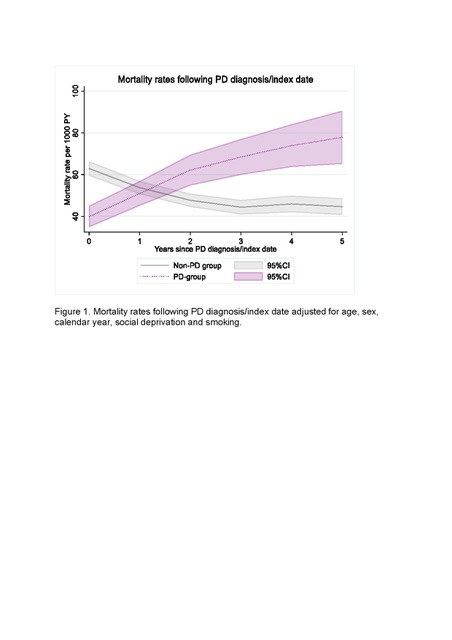Category: Epidemiology
Objective: To explore how PD mortality rates have changed over time and their relationship to disease progression, age, gender and social deprivation using a large UK-based cohort from The Health Improvement Network (THIN).
Background: Parkinson’s disease (PD) is associated with increased mortality, but little is known on changes over time, and its relationship to disease progression and other sociodemographic variables.
Method: Individuals aged 50 years and over with a first recording of PD diagnosis code and at least two prescriptions of any antiparkinsonian drug actively registered within a general practice from 2006 to 2016; up to six randomly selected controls without PD, frequency-matched on age, gender, year and general practice. We estimated adjusted mortality rates using multivariable Poisson regression. We also explored the impact of disease duration and sociodemographic variables on PD mortality.
Results: 10,104 people with a diagnosis of PD and 55,664 people without PD were included in the analysis. Overall, PD was associated with increased mortality compared to non-PD controls (adjusted mortality rate ratio: 1.14 (95% CI 1.03 to 1.19). Adjusted mortality rates for people with PD approximately doubled in the five years following diagnosis from 38 (95%CI 34 to 43) to 80 (95%CI 67 to 93) [Figure 1]. Following adjustments for age, gender and time since diagnosis, mortality rates between 2007 and 2016 declined more slowly for people with PD (2% per year; 95%CI: 0-4%) compared to people without PD (5% per year; 95%CI: 3-6%). These differences over time meant that in the most recent year of data (2016), adjusted mortality rates were around twice as high for people with PD compared to people without PD. Mortality rates across other sociodemographic variables were similar for people with and without PD although the relative differences in mortality rates were somewhat stronger for non-smokers and those living in the least deprived areas.
Conclusion: Whilst mortality in PD is only slightly increased overall, it gradually increases with advancing disease. There has been a slight decline in mortality in PD over the studied time period, but this decrease was less pronounced than that in the general population. These data highlight the impact of advancing disease on mortality, and emphasises the need for the development of treatments to slow the progression of PD.
To cite this abstract in AMA style:
O. Okunoye, L. Horsfall, L. Marston, K. Walters, A. Schrag. Mortality of people with Parkinson’s disease in a large population-based cohort study. Time trends and relationship to disease progression. [abstract]. Mov Disord. 2021; 36 (suppl 1). https://www.mdsabstracts.org/abstract/mortality-of-people-with-parkinsons-disease-in-a-large-population-based-cohort-study-time-trends-and-relationship-to-disease-progression/. Accessed April 3, 2025.« Back to MDS Virtual Congress 2021
MDS Abstracts - https://www.mdsabstracts.org/abstract/mortality-of-people-with-parkinsons-disease-in-a-large-population-based-cohort-study-time-trends-and-relationship-to-disease-progression/

